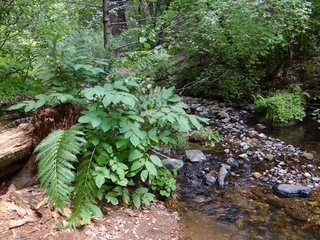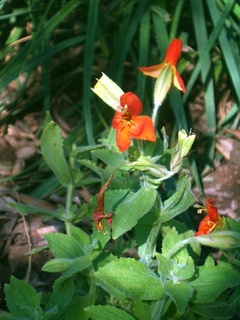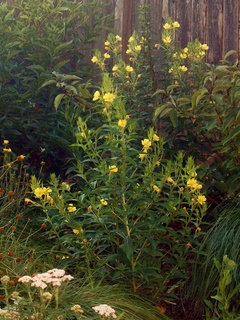 A canal in Hammon Grove Park supports a valley/foothill true riparian forest, with a dense stand of Western sycamore trees. Photo by queerbychoice. Riparian forest is the plant community native to the banks of rivers, lakes, and year-round streams or ponds that are deep enough to have a current. Standing water that is too shallow to have a current belongs to the freshwater marsh plant community instead.
A canal in Hammon Grove Park supports a valley/foothill true riparian forest, with a dense stand of Western sycamore trees. Photo by queerbychoice. Riparian forest is the plant community native to the banks of rivers, lakes, and year-round streams or ponds that are deep enough to have a current. Standing water that is too shallow to have a current belongs to the freshwater marsh plant community instead.
Riparian forest is not the type of forest that you probably first think of when you hear the word forest—one where trees grow densely in all directions for miles and miles, such as in Plumas National Forest or Tahoe National Forest. Instead, riparian forest is a narrow strip of trees—particular species of trees that need a lot of water to survive—growing densely along the bank of a river or stream. Riparian forest can grow in the middle of another type of forest, such as yellow pine forest, but it can also grow in the middle of valley grassland or any other area where there is no forest in sight except in the narrow strip of land along the the river or stream.
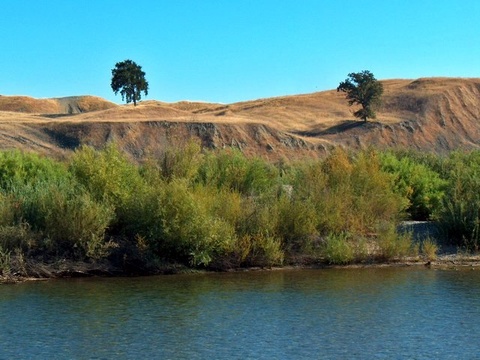 The Yuba River at Hammon Grove Park supports a valley/foothill riparian understory of water-loving shrubs but few riparian trees. The brown hills in the background, dotted with oak trees, belong to the central oak woodland plant community—although the brown color comes from invasive European annual grasses. Before these European grasses were introduced, all the hills of northern California were typically mostly green—or blooming with flowers—all year round. Photo by queerbychoice. To support a true riparian forest with a dense stand of riparian trees, a river must overflow frequently into a floodplain extending at least 50 meters beyond the actual sloping banks that normally channel the water. If a stream, lake, or pond doesn't overflow frequently enough to support riparian plants in a wider floodplain, it may instead support a riparian understory, consisting of the same shrubs, grasses, and forbs that are typical of true riparian forest, but there may be few or no riparian trees. When the flat ground directly above the sloping banks that channel the water contains mostly oaks, conifers, or no trees at all, this indicates that the flat ground belongs to the central oak woodland, yellow pine forest, or valley grassland plant communities, respectively. When the flat ground contains the riparian plants listed below, this indicates that the flat ground is a floodplain that supports a true riparian forest. Different plants within the riparian forest plant community tend to grow at slightly different distances from the water (and some even grow directly in the water), but all of them benefit from having a constant source of water nearby all year long.
The Yuba River at Hammon Grove Park supports a valley/foothill riparian understory of water-loving shrubs but few riparian trees. The brown hills in the background, dotted with oak trees, belong to the central oak woodland plant community—although the brown color comes from invasive European annual grasses. Before these European grasses were introduced, all the hills of northern California were typically mostly green—or blooming with flowers—all year round. Photo by queerbychoice. To support a true riparian forest with a dense stand of riparian trees, a river must overflow frequently into a floodplain extending at least 50 meters beyond the actual sloping banks that normally channel the water. If a stream, lake, or pond doesn't overflow frequently enough to support riparian plants in a wider floodplain, it may instead support a riparian understory, consisting of the same shrubs, grasses, and forbs that are typical of true riparian forest, but there may be few or no riparian trees. When the flat ground directly above the sloping banks that channel the water contains mostly oaks, conifers, or no trees at all, this indicates that the flat ground belongs to the central oak woodland, yellow pine forest, or valley grassland plant communities, respectively. When the flat ground contains the riparian plants listed below, this indicates that the flat ground is a floodplain that supports a true riparian forest. Different plants within the riparian forest plant community tend to grow at slightly different distances from the water (and some even grow directly in the water), but all of them benefit from having a constant source of water nearby all year long.
Riparian forest manifests itself somewhat differently at different elevations. Where the surrounding area belongs to the central oak woodland or valley grassland plant communities—in other words, anywhere in Sutter County and anywhere below approximately 1,600 feet in Yuba County—the riparian forest is sometimes called valley/foothill riparian forest. Western sycamores and Frémont's cottonwoods are the most dominant trees in valley/foothill riparian forest, but box elders, white alders, Oregon ashes, Southern California black walnuts, blue elderberries, and various native willows are also very common trees here. The most common shrubs and vines in valley/foothill riparian forest are California buttonbushes, California wild roses, California wild grapes, and Pacific blackberries.1
Where the surrounding area belongs to the yellow pine forest plant community—in other words, anywhere above approximately 1,600 feet in Yuba County—the riparian forest is sometimes called montane riparian forest. Bigleaf maples and white alders are the most dominant trees in Yuba County's montane riparian forest, but mountain alders, miner's dogwoods, Oregon ashes, Western azaleas, and various native willows are also very common trees here, and red-twig dogwoods are the most common shrubs.2
According to some estimates, as much as 89% of the riparian forest in California's Central Valley has been destroyed during the last 150 years.3 The 3,700-acre area of the Feather River's riparian forest from Nicolaus north to the Star Bend Park and Boat Ramp, much of which is included in the Bobelaine Audubon Sanctuary and/or the Feather River State Wildlife Area, is the largest contiguous example of mixed riparian forest remaining in California's Central Valley.4
The plants listed below are native to riparian forest in Yuba and/or Sutter Counties.5
Trees
 Bigleaf maple (Acer macrophyllum) on the Feather River Little North Fork, north of Strawberry Valley. Photo by queerbychoice. (See the Willows page for more information about some of these species.)
Bigleaf maple (Acer macrophyllum) on the Feather River Little North Fork, north of Strawberry Valley. Photo by queerbychoice. (See the Willows page for more information about some of these species.)
mountain alder* (also called creek alder)
miners' dogwood (also called blackfruit dogwood or Western cornelian cherry)
Southern California black walnut**
Western sycamore (also called California sycamore)
sandbar willow (also called narrowleaf willow)
red willow (also called polished willow)
* not typically found in valley/foothill riparian areas
** not typicallly found in montane riparian areas
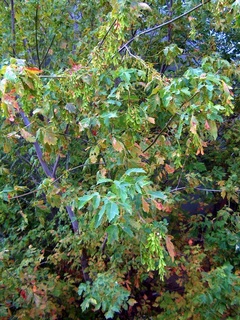 Box elder (Acer negundo) in Beckwourth Riverfront Park Complex, displaying seeds in October. Photo by queerbychoice.
Box elder (Acer negundo) in Beckwourth Riverfront Park Complex, displaying seeds in October. Photo by queerbychoice.  White alder (Alnus rhombifolia) on the Feather River Little North Fork, north of Strawberry Valley. Photo by queerbychoice.
White alder (Alnus rhombifolia) on the Feather River Little North Fork, north of Strawberry Valley. Photo by queerbychoice. 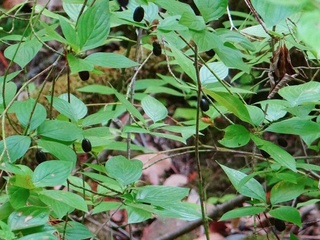 Blackfruit dogwood (Cornus sessilis) with fruit, growing alongside Frey Creek on the Feather Falls trail. Photo by queerbychoice.
Blackfruit dogwood (Cornus sessilis) with fruit, growing alongside Frey Creek on the Feather Falls trail. Photo by queerbychoice.  Oregon ash (Fraxinus latifolia) in the American River Parkway. Photo by queerbychoice.
Oregon ash (Fraxinus latifolia) in the American River Parkway. Photo by queerbychoice. 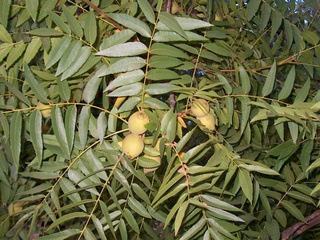 California Walnut (Juglans californica) in the American River Parkway. Photo by queerbychoice.
California Walnut (Juglans californica) in the American River Parkway. Photo by queerbychoice. 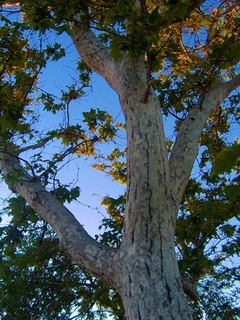 Western sycamore (Platanus racemosa) next to the 10th Street Bridge in Yuba City. Photo by queerbychoice.
Western sycamore (Platanus racemosa) next to the 10th Street Bridge in Yuba City. Photo by queerbychoice. 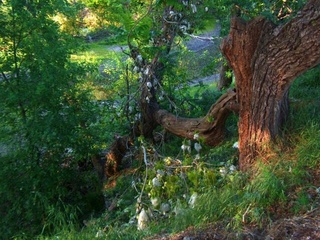 Frémont's cottonwood (Populus fremontii) in the American River Parkway, with cotton-like seeds. The tree is named for John C. Frémont. Photo by queerbychoice.
Frémont's cottonwood (Populus fremontii) in the American River Parkway, with cotton-like seeds. The tree is named for John C. Frémont. Photo by queerbychoice. 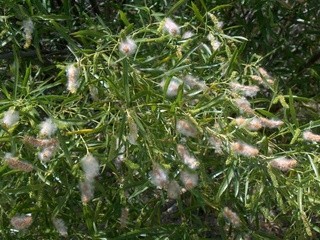 A female sandbar willow (Salix exigua) sheds its seeds into the Yuba River in Timbuctoo. Photo by queerbychoice.
A female sandbar willow (Salix exigua) sheds its seeds into the Yuba River in Timbuctoo. Photo by queerbychoice. 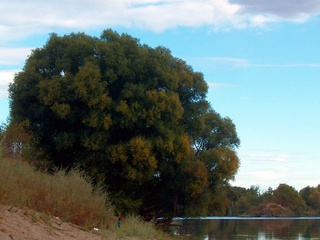 San Joaquin black willow (Salix gooddingii) on the Feather River in Beckwourth Riverfront Park Complex. Photo by queerbychoice.
San Joaquin black willow (Salix gooddingii) on the Feather River in Beckwourth Riverfront Park Complex. Photo by queerbychoice. 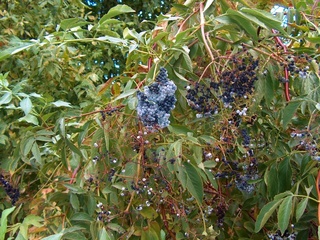 Blue elderberry (Sambucus mexicana) in Beckwourth Riverfront Park Complex. The unripe berries have a white coating, which slowly wears away as the berries ripen. Photo by queerbychoice.
Blue elderberry (Sambucus mexicana) in Beckwourth Riverfront Park Complex. The unripe berries have a white coating, which slowly wears away as the berries ripen. Photo by queerbychoice.
Shrubs
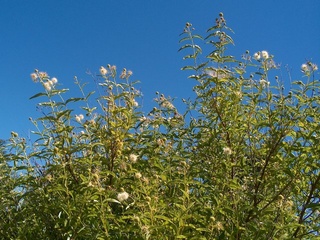 California buttonbush (Cephalanthus occidentalis) in the American River Parkway. Photo by queerbychoice. (See the Roses page for more information about some of these species.)
California buttonbush (Cephalanthus occidentalis) in the American River Parkway. Photo by queerbychoice. (See the Roses page for more information about some of these species.)
Western false indigo** (also called desert indigobush)
mulefat (also called seep willow)
sweet shrub (also called spicebush)
red-twig dogwood (also called red osier dogwood or American creek dogwood)
Oregon spicy wintergreen* (also called Western teaberry)
cream bush (also called ocean spray)
rock spiraea* (also called small-leaf cream bush or ocean spray)
Sierra sweet bay* (also called Sierra bayberry or mountain wax myrtle)
Pacific ninebark (also called Western ninebark)
* not typically found in valley/foothill riparian areas
** not typicallly found in montane riparian areas
 A red-twig dogwood (Cornus sericea) shows off its fall colors in a Marysville garden. Photo by queerbychoice.
A red-twig dogwood (Cornus sericea) shows off its fall colors in a Marysville garden. Photo by queerbychoice. 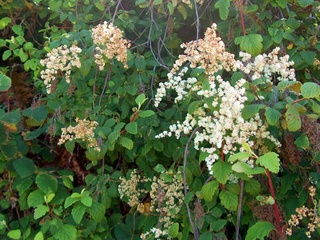 Ocean spray (Holodiscus discolor). Photo by queerbychoice.
Ocean spray (Holodiscus discolor). Photo by queerbychoice.  Pacific ninebark (Physocarpus capitatus) blooms in a garden in Marysville. Photo by queerbychoice.
Pacific ninebark (Physocarpus capitatus) blooms in a garden in Marysville. Photo by queerbychoice. 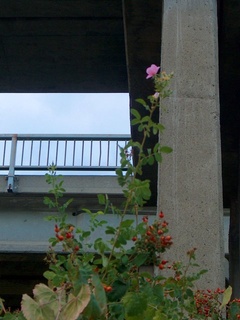 California wild rose (Rosa californica) under the 5th Street Bridge, with hips and one remaining flower in October. Photo by queerbychoice.
California wild rose (Rosa californica) under the 5th Street Bridge, with hips and one remaining flower in October. Photo by queerbychoice.
Vines
 California wild grape (Vitis californica) in the small state wildlife area next to the Marysville City Cemetery. Photo by queerbychoice. (See the Native Edible Fruits page for more information about some of these species.)
California wild grape (Vitis californica) in the small state wildlife area next to the Marysville City Cemetery. Photo by queerbychoice. (See the Native Edible Fruits page for more information about some of these species.)
virgin's bower (also called Western white clematis, yerba de chiva, or creek clematis)
Pacific blackberry (also called California blackberry)
Herbaceous Perennials
Monocots
Grasses and Grass-like Plants
True Grasses
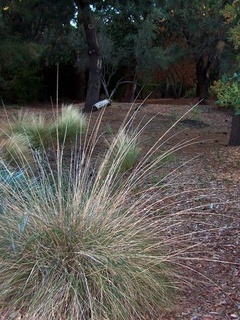 Deergrass (Muhlenbergia rigens) in the California State University Sacramento arboretum. Photo by queerbychoice. (See the Bentgrasses page for more information about some of these species.)
Deergrass (Muhlenbergia rigens) in the California State University Sacramento arboretum. Photo by queerbychoice. (See the Bentgrasses page for more information about some of these species.)
spike bentgrass (also called spike redtop)
Idaho bentgrass (also called colonial bentgrass)
fowl mannagrass (also called tall mannagrass)
northwestern mannagrass** (also called Western mannagrass or waxy mannagrass)
Great Basin wild rye (also called gray wild rye or giant wild rye)
creeping wild rye (also called valley wild rye, alkali rye, or beardless wild rye)
pullup muhly* (also called slender muhly)
* not typically found in valley/foothill riparian areas
** not typicallly found in montane riparian areas
Sedges
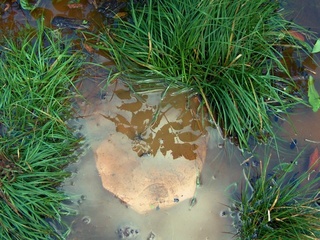 Clustered field sedge (Carex praegracilis) surrounds a submerged stepping-stone in a seasonally flooded garden in Marysville. Clustered field sedge grows very well in heavy clay soils that tend to be very dry in the summer but very wet in the winter. Photo by queerbychoice. (See the Sedges page for more information about some of these species.)
Clustered field sedge (Carex praegracilis) surrounds a submerged stepping-stone in a seasonally flooded garden in Marysville. Clustered field sedge grows very well in heavy clay soils that tend to be very dry in the summer but very wet in the winter. Photo by queerbychoice. (See the Sedges page for more information about some of these species.)
bigleaf sedge (also called ampleleaf sedge)
widefruit sedge* (also called narrowleaf sedge)
valley sedge (also called Santa Barbara sedge)
star sedge (also called stellate sedge or bristlefruit sedge)
torrent sedge (also called naked sedge)
clustered field sedge (also called expressway sedge)
awlfruit sedge (also called owlfruit sedge)
straw-colored flatsedge (also called false nutsedge)
common creeping spikerush (also called pale spikerush or wiregrass)
sand spikerush (also called Montevideo spikerush)
capitate beakrush (also called brownish beaksedge)
panicled bulrush (also called smallfruit bulrush or mountain bog bulrush)
* not typically found in valley/foothill riparian areas
** not typicallly found in montane riparian areas
Rushes
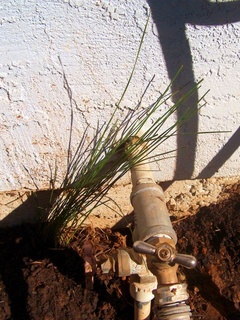 Wire rush (Juncus balticus) next to an outdoor faucet in Marysville. Photo by queerbychoice. (See the Rushes page for more information about some of these species.)
Wire rush (Juncus balticus) next to an outdoor faucet in Marysville. Photo by queerbychoice. (See the Rushes page for more information about some of these species.)
tapertip rush** (also called sharpfruit rush)
jointed rush (also called jointleaf rush)
wire rush (also called Baltic rush)
Western toad rush (also called roundfruit toad rush)
dubius rush (also called Mariposa rush)
common bog rush (also called soft rush)
three-stamen rush (also called threestem rush or swordleaf rush)
poverty rush (also called slender rush)
* not typically found in valley/foothill riparian areas
** not typicallly found in montane riparian areas
Bulbs and Corms
Asparagus Family
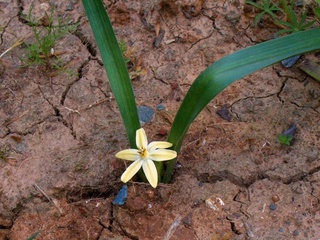 Golden prettyface (Triteleia ixioides) blooms in a garden in Marysville. Photo by queerbychoice. (See the Cluster-Lilies page for more information about these species.)
Golden prettyface (Triteleia ixioides) blooms in a garden in Marysville. Photo by queerbychoice. (See the Cluster-Lilies page for more information about these species.)
crown cluster-lily (also called early harvest cluster-lily)
blue dicks (also called wild hyacinth)
white prettyface (also called wild hyacinth)
Orchid Family
stream orchid (also called giant helleborine)
broadleaf twayblade* (also called broadlip twayblade)
* not typically found in valley/foothill riparian areas
Other Bulbs and Corms
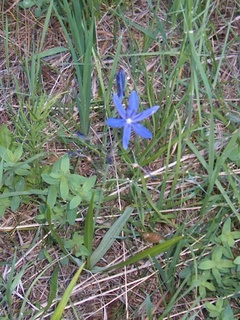 Smallflower camas (Camassia quamash) at Snake Lake, near Quincy. Photo by queerbychoice. (See the Tulips page for more information about some of these species.)
Smallflower camas (Camassia quamash) at Snake Lake, near Quincy. Photo by queerbychoice. (See the Tulips page for more information about some of these species.)
feathery false lily of the valley
Western large false Solomon's seal (also called racemose false Solomon's seal, fat Solomon, or branched false Solomon's seal)
narrowleaf cattail** (also called nail rod)
common broadleaf cattail (also called soft flag)
California corn lily* (also called California false hellebore)
meadow death camas (also called meadow zigadene)
* not typically found in valley/foothill riparian areas
** not typicallly found in montane riparian areas
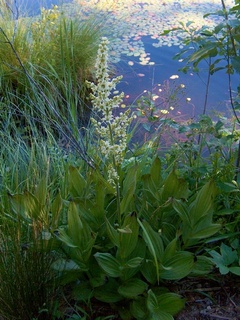 California corn lily (Veratrum californicum) at Snake Lake, near Quincy. Photo by queerbychoice.
California corn lily (Veratrum californicum) at Snake Lake, near Quincy. Photo by queerbychoice.
Dicots
Aster Family
 The large yellow flowers and spiky, gum-filled buds of hairy gumplant (Grindelia hirsutula) mingle with smaller rosilla (Helenium puberulum) flowers, whose tiny yellow petals hang down below the brown-topped ball of pollen, in a garden in Marysville. Two green rosilla buds are visible, one on each side of the main rosilla flower, which is at bottom center. Photo by queerbychoice. (See the Daisies page for more information about some of these species.)
The large yellow flowers and spiky, gum-filled buds of hairy gumplant (Grindelia hirsutula) mingle with smaller rosilla (Helenium puberulum) flowers, whose tiny yellow petals hang down below the brown-topped ball of pollen, in a garden in Marysville. Two green rosilla buds are visible, one on each side of the main rosilla flower, which is at bottom center. Photo by queerbychoice. (See the Daisies page for more information about some of these species.)
Western goldentop (also called Western flat-top goldenrod)
* not typically found in valley/foothill riparian areas
** not typically found in montane riparian areas
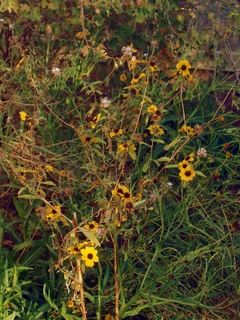 Serpentine sunflower (Helianthus bolanderi) blooms with the smaller flowers of rosillas (Helenium puberulum) in a Marysville garden. Photo by queerbychoice.
Serpentine sunflower (Helianthus bolanderi) blooms with the smaller flowers of rosillas (Helenium puberulum) in a Marysville garden. Photo by queerbychoice. 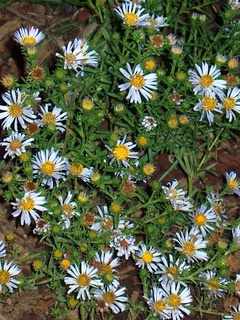 California aster (Symphyotrichum chilense) in a garden in Marysville. Photo by queerbychoice.
California aster (Symphyotrichum chilense) in a garden in Marysville. Photo by queerbychoice.
Mustard Family
American erectpod wintercress* (also called American rocket)
common Virginia winged rockcress**
* not typically found in valley/foothill riparian areas
** not typicallly found in montane riparian areas
Pea Family
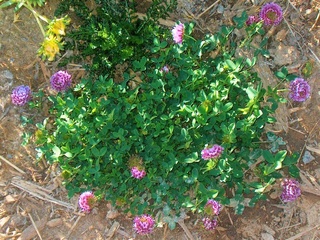 Cow clover (Trifolium wormskioldii) in a garden in Marysville. Photo by queerbychoice. (See the Deervetches, Lupines, and Clovers pages for more information about some of these species.)
Cow clover (Trifolium wormskioldii) in a garden in Marysville. Photo by queerbychoice. (See the Deervetches, Lupines, and Clovers pages for more information about some of these species.)
large leather root (also called California hemp)
roundleaf leather root (also called creeping leather root)
narrowleaf deervetch (also called streambank bird's foot trefoil)
pinnateleaf deervetch* (also called meadow bird's foot trefoil)
broadleaf lupine (also called bigleaf lupine)
meadow lupine (also called largeleaf lupine)
cow's clover (also called springbank clover)
** not typicallly found in montane riparian areas
Buttercup Family
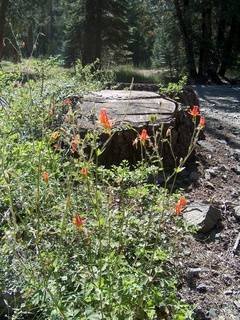 Western columbine (Aquilegia formosa) at Bowman Lake in Nevada County. Photo by queerbychoice. (See the Buttercups page for more information about some of these species.)
Western columbine (Aquilegia formosa) at Bowman Lake in Nevada County. Photo by queerbychoice. (See the Buttercups page for more information about some of these species.)
blue windflower (also called Western wood anemone)
Western columbine (also called crimson columbine)
smooth buttercup* (also called sagebrush buttercup)
* not typically found in valley/foothill riparian areas
Other Plant Families
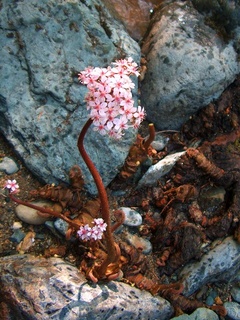 Indian rhubarb (Darmera peltata) on the Feather River Little North Fork, north of Strawberry Valley. Photo by queerbychoice. (See the Milkweeds, Willowherbs, Monkeyflowers, and Skullcaps pages for more information about some of these species.)
Indian rhubarb (Darmera peltata) on the Feather River Little North Fork, north of Strawberry Valley. Photo by queerbychoice. (See the Milkweeds, Willowherbs, Monkeyflowers, and Skullcaps pages for more information about some of these species.)
California spikenard (also called elk clover or prairie sagewort)
narrowleaf milkweed (also called Mexican whorled milkweed)
Indian rhubarb (also called umbrella plant)
Fringed Northern willowherb (also called slender willowherb)
alkali seaheath** (also called yerba reuma)
seaside heliotrope (also called Chinese parsley or salt heliotrope)
grassleaf mudplantain (also called water stargrass)
tinker's penny (also called creeping St. John's wort)
caraway-leaf desertparsley (also called alkali desertparsley)
marsh seedbox (also called marsh purslane)
floating water primrose (also called floating primrose willow or marsh purslane)
field mint (also called marsh mint or American wild mint)
seep monkeyflower (also called common yellow monkeyflower)
turkey tangle fogfruit** (also called common lippia)
soft popcornflower** (also called downy popcorn flower)
California figwort (also called bee plant)
American black nightshade (also called smallflower nightshade or white nightshade)
Western woodland star (also called Western star flower)
American speedwell (also called American brooklime)
Brazilian watermeal** (also called South American watermeal)
* not typically found in valley/foothill riparian areas
** not typicallly found in montane riparian areas
California spikenard (Aralia californica) grows next to Frey Creek on the Feather Falls trail in Oroville. The fern fronds protruding from underneath it belong to a giant chain fern (Woodwardia fimbriata). Photo by queerbychoice.
Scarlet monkeyflower (Mimulus cardinalis) in a garden in Marysville. Photo by queerbychoice.
The yellow flowers of two Hooker's evening-primrose (Oenothera elata) plants bloom in a garden in Marysville, along with white yarrow, golden brown rosillas, and a few small yellow hairy gumplants. Photo by queerbychoice.
 Turkey tangle fogfruit (Phyla nodiflora) on a Marysville levee. Photo by queerbychoice.
Turkey tangle fogfruit (Phyla nodiflora) on a Marysville levee. Photo by queerbychoice.
<div>
 Common selfeal (Prunella vulgaris) at Snake Lake, near Quincy. Photo by queerbychoice.
Common selfeal (Prunella vulgaris) at Snake Lake, near Quincy. Photo by queerbychoice.  California figwort (Scrophularia californica) blooming in a Marysville garden. Photo by queerbychoice.
California figwort (Scrophularia californica) blooming in a Marysville garden. Photo by queerbychoice.
Ferns
 Giant chain fern (Woodwardia fimbriata) turns yellow in the summer due to drought stress. Photo by queerbychoice. (See the Maidenhair Ferns, Horsetails, and Wood Ferns pages for more information about these and other fern and horsetail species.)
Giant chain fern (Woodwardia fimbriata) turns yellow in the summer due to drought stress. Photo by queerbychoice. (See the Maidenhair Ferns, Horsetails, and Wood Ferns pages for more information about these and other fern and horsetail species.)
five-finger fern (also called Western maidenhair fern)
Pacific mosquitofern (also called American waterfern)
common leathery grapefern (also called broadleaf grapefern)
smooth horsetail (also called smooth scouring rush horsetail)
giant chain fern (also called Western chain fern)
* not typically found in valley/foothill riparian areas
** not typicallly found in montane riparian areas
Annuals
Monocots
Grasses and Grass-like Plants
True Grasses
(See the Bentgrasses page for more information about some of these species.)
dwarf alkali barley (also called low barley)
Sedges
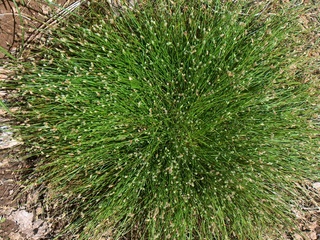 Fiber-optic bulrush (Isolepis cernua) in a Marysville garden. Photo by queerbychoice. (See the Rushes pages for more information about these and other rush species.) (See the Sedges page for more information about some of these species.)
Fiber-optic bulrush (Isolepis cernua) in a Marysville garden. Photo by queerbychoice. (See the Rushes pages for more information about these and other rush species.) (See the Sedges page for more information about some of these species.)
bearded flatsedge (also called umbrella flatsedge or awned flatsedge)
blunt spikerush (also called broadspike spikerush)
annual tule (also called low clubrush)
Rushes
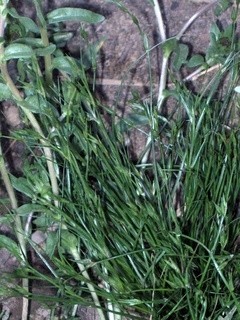 Toad rush (Juncus bufonius) volunteers in a Marysville back yard in early spring. Photo by queerbychoice. (See the Rushes pages for more information about these and other rush species.)
Toad rush (Juncus bufonius) volunteers in a Marysville back yard in early spring. Photo by queerbychoice. (See the Rushes pages for more information about these and other rush species.)
twelfth rush (also called inch-high dwarf rush)
Dicots
Aster Family
 Yellowray goldfields (Lasthenia glabrata) in a garden in Marysville. Photo by queerbychoice. (See the Daisies, Goldfields, Tarweeds, and Tidytips pages for more information about some of these species.)
Yellowray goldfields (Lasthenia glabrata) in a garden in Marysville. Photo by queerbychoice. (See the Daisies, Goldfields, Tarweeds, and Tidytips pages for more information about some of these species.)
annual water aster (also called slimaster)
devil's beggartick (also called sticktight)
Western pineappleweed (also called Western chamomile)
Western marsh cudweed (also called lowland cudweed)
dwarf cudweed (also called hogwallow starfish)
short woollyheads (also called short woolly marbles)
Oregon woollyheads (also called Oregon woolly marbles)
slender woollyheads (also called slender woolly marbles)
spiny cockleburr (also called spiny clotbur)
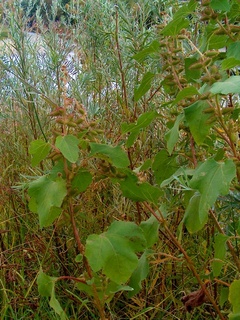 Rough cockleburr (Xanthium strumarium) in Beckwourth Riverfront Park Complex. Photo by queerbychoice.
Rough cockleburr (Xanthium strumarium) in Beckwourth Riverfront Park Complex. Photo by queerbychoice.
Borage Family
finebranched popcornflower (also called alkali popcornflower)
stalked popcornflower (also called vernal pool allocarya)
Pacific popcornflower (also called slender popcornflower)
Bellflower Family
doublehorn calicoflower (also called bristled calicoflower)
folded calicoflower (also called horned calicoflower)
Pea Family
 The reddish purple flowers of cowbag clover (Trifolium depauperatum) emerge from among invasive, non-native filarees on Table Mountain. Photo by queerbychoice. (See the Clovers pages for more information about some of these species.)
The reddish purple flowers of cowbag clover (Trifolium depauperatum) emerge from among invasive, non-native filarees on Table Mountain. Photo by queerbychoice. (See the Clovers pages for more information about some of these species.)
bowl clover (also called cup clover)
cowbag clover (also called dwarf sack clover or pale sack clover)
sour clover (also called bull clover)
clammy clover (also called creek clover)
whitetip clover (also called variegated clover)
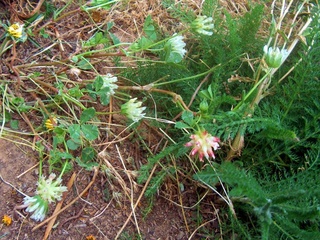 Sour clover (Trifolium fucatum) blooms in a garden in Marysville. Photo by queerbychoice.
Sour clover (Trifolium fucatum) blooms in a garden in Marysville. Photo by queerbychoice. 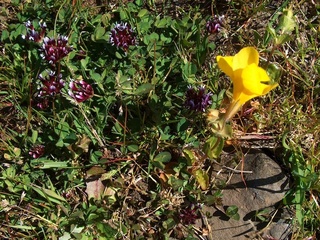 Whitetip clover (Trifolium variegatum) with a yellow seep monkeyflower (Mimulus guttatus) on Table Mountain. Photo by queerbychoice.
Whitetip clover (Trifolium variegatum) with a yellow seep monkeyflower (Mimulus guttatus) on Table Mountain. Photo by queerbychoice.
Lopseed Family
(See the Monkeyflowers page for more information about these and other monkeyflower species.)
brownies (also called purple mouse ears)
Phlox Family
Other Families
 An all-white form of common meadowfoam (Limnanthes douglasii) on Table Mountain. Other forms of this species have pale pinkish flowers, bright yellow flowers, or white flowers with bright yellow centers. Photo by queerbychoice. (See the Willowherbs page for more information about some of these species.)
An all-white form of common meadowfoam (Limnanthes douglasii) on Table Mountain. Other forms of this species have pale pinkish flowers, bright yellow flowers, or white flowers with bright yellow centers. Photo by queerbychoice. (See the Willowherbs page for more information about some of these species.)
spear orache (also called fat-hen saltweed)
vernal pool Indian paintbrush (also called yellow owl's clover)
hairy Indian paintbrush (also called hairy owl's clover)
shining pepperweed (also called tongue grass)
Owyhee stemless mudwort (also called Southern broadleaf mudwort)
annual water miners' lettuce (also called water chickweed)
Southern water nymph (also called Guadalupe water nymph)
curlytop knotweed (also called willow smartweed)
broadleaf knotweed (also called little mountain knotweed or leafy dwarf knotweed)
fruitleaf knotweed (also called dense knotweed)
neckweed (also called hairy purslane speedwell)
 Curlytop knotweed (Polygonum lapathifolium) blooms in Beckwourth Riverfront Park Complex. Photo by queerbychoice.
Curlytop knotweed (Polygonum lapathifolium) blooms in Beckwourth Riverfront Park Complex. Photo by queerbychoice. 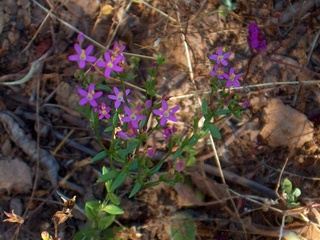 Monterey centaury (Zeltnera muehlenbergii) volunteers in a garden in Marysville. Photo by queerbychoice.
Monterey centaury (Zeltnera muehlenbergii) volunteers in a garden in Marysville. Photo by queerbychoice.
Footnotes
1. California Department of Fish and Game: Wildlife Habitats—California Wildlife Habitat Relationships System
2. California Department of Fish and Game: Wildlife Habitats—California Wildlife Habitat Relationships System
3. U.S. Fish & Wildlife Service: Sacramento Fish & Wildlife Office: Species Account: Valley Elderberry Longhorn Beetle
4. Sutter County General Plan § 9.8 Biological Resources, 1994
5. CalFlora.org
</div>

